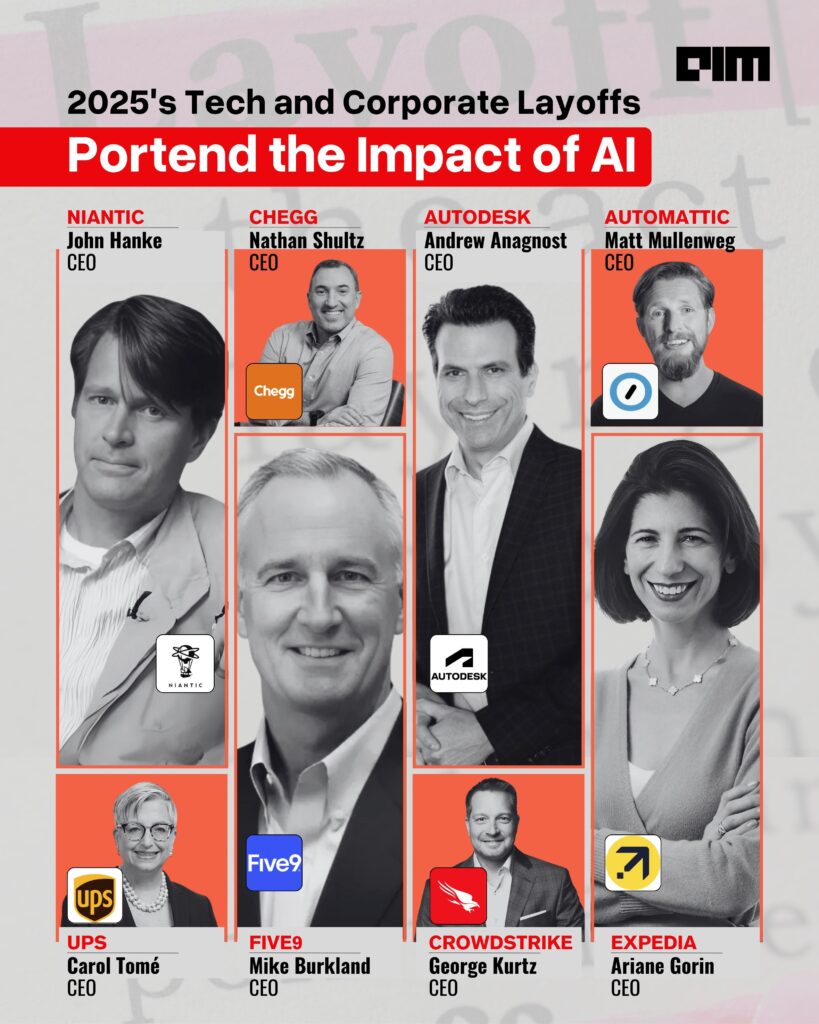According to Salesforce exec Andy Valenzuela, companies need to lean in when it comes to AI: “I think it is really about creating orgs that are flexible, creating orgs that are going to allow for these agentic capabilities—and leaning in.”
AI agents are going to create value for companies in the long term. That may be true (obvious, even), but in the lead up to adapting for AI, real jobs, and the humans who work them are getting affected, leading to massive layoffs across industries.
Education platforms like Chegg, software corps like Autodesk, and a growing number of other firms are cutting staff not simply because of declining performance, but to recalibrate and restructure for AI. Whether it’s direct automation, strategic restructuring, or a pivot toward machine learning capabilities, these layoffs show that AI is already having an impact on the industry.

Chegg
CEO: Nathan Shultz
Layoffs: 248 Personnel
Why?
“…students are increasingly turning to AI-powered tools.” – Nathan Schultz.
In May 2025, Chegg, the online education platform, announced it would cut roughly 22% of its workforce (248 employees) as it faces mounting competition from AI-driven learning platforms.
Chegg has seen a significant drop in web traffic and subscriber numbers as students are relying on tools like ChatGPT, Google’s Gemini, and other free AI-powered academic services.
According to Chegg, a major problem is that Google’s AI Overviews is keeping web traffic confined within search. The free subscription to OpenAI and Anthropic also contribute to Chegg’s difficulties.
In response, the company is undertaking a broad restructuring aimed at reducing costs and refocusing operations.
Niantic Spatial
CEO: John Hanke
Layoffs: 68 people
Why?
“…after a lot of consideration, it became clear that some roles would not be required given our new focus.” – John Hanke.
Back in April, Niantic CEO John Hanke announced through an email to Niantic employees that the company was officially splitting into two separate entities: one focused on its games business, and the other, Niantic Spatial Inc., dedicated to advancing geospatial AI.
Along with this announcement, he confirmed that some roles would be affected due to their new focus. The cuts, effective May 20, 2025, were revealed in a California WARN Act notice before being confirmed through the company wide email.
Niantic Spatial, now a fledgling standalone tech company, received $50 million when Niantic was acquired by Scopely, along with $250 million in funding, and $200 million from Niantic’s balance sheet, right before announcing the layoffs.
While AI may not have affected Niantic Spatial in the sense that it replaced jobs, we can see that their reprioritization towards shiny new tech (something we will see more of in the years to come) had an unfortunate effect on the company’s workforce.
Five9
CEO: Mike Burkland
Layoffs: 4% of workforce
Why?
After cutting 7% of its staff in August 2024, Five9 has now announced plans to lay off approximately 4% of its full-time workforce (around 123 employees) by the end of the 2nd quarter of 2025, as it shifts its strategic focus towards areas like artificial intelligence.
The ongoing wave of layoffs at Five9 shows us how AI is reshaping the workforce even in sectors where human interaction has traditionally been central.
The company, which had over 3,000 employees at the end of 2024, says the decision is part of an effort to realign operations with strategic priorities, chief among them, investing in AI and driving profitable growth.
Automattic
CEO: Matt Mullenweg
Layoffs: 16% of workforce
Why?
“…we must improve our productivity, profitability, and capacity to invest.” – Matt Mullenweg.
In a message sent to all “Automatticians” in April, Automattic CEO Matt Mullenweg laid out a shift in the company’s structure: a reduction of approximately 16% of its global workforce.
In mid-2024, Automattic deepened its push into AI by introducing a writing assistant to help WordPress users craft clearer, more engaging posts. That same year, it also acquired WPAI, creators of tools like CodeWP and AgentWP, signaling a broader strategy to embed intelligent features directly into its content and development platforms.
Notably, this restructuring doesn’t explicitly cite artificial intelligence as a cause, but its influence lingers in the background. In a landscape where AI is reshaping digital publishing, commerce, and online community building, companies like Automattic must recalibrate to keep pace.
Autodesk
CEO: Andrew Anagnost
Layoffs: 9% of workforce
Why?
“Our investments in cloud, platform, and AI are ahead of our peers and enable Autodesk to provide more valuable and connected solutions that support a much broader customer and developer ecosystem. To maintain and extend this leadership, we are shifting resources across our GTM, Platform, Industry, and Corporate functions” – Andrew Anagnost.
In early 2025, Autodesk CEO Andrew Anagnost informed employees that the company would be letting go of approximately 1,350 workers, roughly 9% of its global workforce, and reorganizing with the aim of reshaping its go-to-market strategy and accelerating investments in AI and cloud technologies.
Much like other tech firms recalibrating for an AI-led future (Niantic Spatial, for instance), Autodesk’s layoffs are not simply the result of automation displacing workers, but a broader reprioritization.
Expedia
CEO: Ariane Gorin
Layoffs: 3% of workforce
Why?
“…we are restructuring parts of our organization.”
Travel brand Expedia Group joined the wave of tech layoffs by cutting approximately 3% of its global workforce (500 employees). Like some of the other companies on this listicle, Expedia attributed the job cuts to a strategic restructuring meant to sharpen its focus on long-term growth and operational efficiency.
With half of Expedia’s workforce in tech roles, the shift likely reflects a broader industry trend: organizations tightening their operations, even amid profitability, to stay competitive in a world where AI is becoming deeply embedded in how work gets done.
CrowdStrike
CEO: George Kurtz
Layoffs: 500 Personnel
Why?
“…AI flattens our hiring curve.” – George Kurtz.
Cybersecurity firm CrowdStrike announced plans to cut 5% of its global workforce, around 500 roles, citing artificial intelligence as a key driver behind the decision.
CEO George Kurtz pointed to AI-driven efficiencies as a major reason, claiming that the technology is accelerating innovation, reducing hiring needs, and streamlining both front and back-office operations. While the company posted strong revenue growth in Q4 2025, it is expected to incur up to $53 million in layoff-related costs.
UPS
CEO: Carol Tomé
Layoffs: 4% of workforce
Why?
In an earnings call, United Parcel Service announced it will lay off 20,000 workers and shutter 73 buildings by June 2025 as part of a sweeping restructuring to cut $3.5 billion in costs this year.
The logistics giant pointed to a convergence of challenges: reduced consumer demand, weakening small business volumes, automation investments, and trade policy uncertainty.
In what may be related news, According to Bloomberg, UPS is in early talks with Figure AI, a startup building humanoid robots. Their flagship model, Figure 02, is human-sized and built to lift, sort, and move packages in spaces designed for people. It could someday work alongside remaining staff in UPS warehouses.











